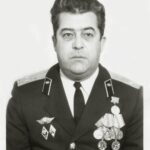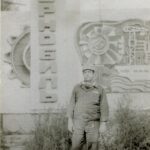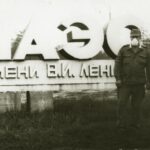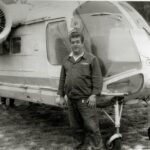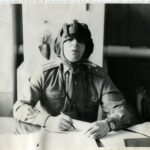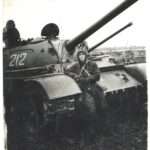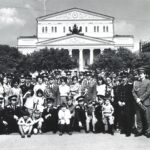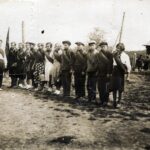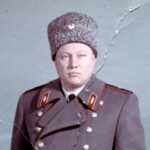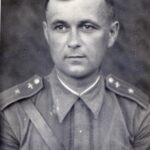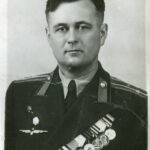Guide to the Cold War Photo Archives M. Blinov (Paris, France)
Part 1. Russian Empire, France, USA and USSR, Color photo
Few people know, but before the First World War, Russian photographer Sergei Prokudin Gorsky was the world leader in color photography. Having received funding from the Tsar, he made a large series of color photographs of the entire Russian Empire, including Borodino and other battlefields of the war with France. During the First World War, without previous funding, Prokudin-Gorsky photographed only some sections of the Murmansk railway in the North of Russia. After the October Revolution of 1917, the Bolsheviks began to massively kill officers of the Russian Imperial Army, engineers, creative workers, and in general all “bourgeois, landlords and capitalists.” Many were killed, some managed to go to France or the United States, as an outstanding aircraft designer Sikorsky, a world leader in the production of helicopters. The photographer Prokudin-Gorsky, who lived in Nice, worked with the Lumiere brothers, read reports and wrote articles for British scientific journals, also managed to emigrate to France. He died in 1944 in Paris and was buried in the Russian cemetery in Sainte-Genevieve-des-Bois. After the Second World War, a unique collection of color photographs was purchased by the US Library of Congress, where it remains to this day.
In the period after the Second World War, many families had cameras, which was facilitated by the fact that factories, technologies, documentation, together with specialists, were seized in Germany. Even the famous Victory Parade, the first Soviet color film, was filmed on captured German film. I would like to note a clear division in the USSR into amateur and professional photography. Professionals worked for Soviet official organizations, the press service of the Central Committee of the CPSU, departments and newspapers, of course, under the control and censorship of the KGB and party organs. Expensive professional cameras with special lenses were issued at the editorial office and surrendered at the end of the work. Printing was carried out in special spacious laboratories with a variety of instruments and strict adherence to the purity of water and temperature. Amateur photographs were taken by ordinary Soviet people in various situations, primarily during a wedding, birthday, on vacation and sometimes at work. In the army and other law enforcement agencies, there was a special prohibitive filming regime with many restrictions.
Thus, we would divide all the photo archives in our collection into professional and amateur, political, military and domestic. Color photography on photo paper or slides is a special category.
Part 2 Cold War photo archives formation
The basis of the collection was collected by a family photo archive, started by Vladimir Blinov during the Second World War and continued by Yuri Blinov, an amateur photographer, a professional officer who served from Brest to Sakhalin, from Smolensk to Leningrad, from Kazakhstan to Lvov. He went down in history as an operational commander on duty for restoration work in Chernobyl in 1986. In addition to black and white photographs of his service, he left a number of color slides taken on Sakhalin in the late 70s. His work was continued by his son, Mikhail Blinov, who during his military service was the secretary of the Komsomol organization and editor of the wall newspaper, that is, he turned out to be a military photographer on his course and faculty. In addition, hundreds of photographs appeared during the entire working life, including in places where it was forbidden to do so. How why? See memories for more…
- Blinov Yuri (Soviet Army, Cold War Museum)
- Chernobyl 1986 accident, Blinov (CWM archives)
- Chernobyl nuclear accident, 1986, plant (CWM)
- Duty helicopter for inspection of plant objects (CWM)
As a result, a unique large photo archive of military service and study was formed in all informal details and situations. The collection becomes even more important and rare in history due to the fact that a certain number of color photographs and many slides were made. For the Soviet period of Comrade Brezhnev, this is a rarity in the army.
Over the years, individual photographs and personal archives of both individuals and celebrities have been bought from various sources. Personal archives of senior officers of the army, tankers, pilots and even the Deputy Chairman of the KGB. Preference was given to photographs of Soviet propaganda, communist education of youth, types of military equipment, uniforms and insignia, and of course the battlefields of the Second World War.
- Military Academy training, 1968 (?), rank of major, N6
- Final exam for the right to drive a tank type T-54, 1959, N5
- Captain rank, field uniform, Czechoslovakia 1968 (?), N8
- Grateful students from Poland, East Germany, Vietnam souvenir photo, Bolshoi Theatre, late 70s, N11
- Komsomolets Pankratov with a red banner
- KGB Deputy Chairman general Pankratov Lev
- 1943, major T.V., old tunic M1937, but with new shoulder straps
- Colonel Fedor Teteryadchenko, 1949 (Cold War Museum)
In Soviet times, only official photographers of the leading newspapers of the Ministry of Defense had permission to photograph military installations. The main military newspaper was Krasnaya Zvezda, which military personnel were required to buy and read. And in the absence of toilet paper in the USSR, guess for yourself its main purpose and in what places. The fate of the Krasnaya Zvezda photo archive is unknown, since there have been many reorganizations during its existence.
Less famous, but no less important, was the newspaper “Na boevom Postu!” (At Combat Post!) of Moscow Air Defense District. Since 1971, a professional photographer Viktor Leontiev worked as a correspondent in it. On the instructions of the editors, he photographed parades on Red Square and exhibitions, went on business trips to the cities of neighboring regions. He not only had special access to secret objects of the Cold War period, but the commanders of military units specifically ordered soldiers and officers to perform actions specifically for photography. This is how hundreds and thousands of photographs appeared with aircraft, pilots, combat crews of air defense missiles, both included in the circulation of the newspaper and not. Of particular interest are his negatives, the quality of which is much better than the pictures themselves. His older friends and colleagues were no less famous photographers, such as Yaroslavtsev, who works for the Bolshevik newspaper and others. Plots about the war and pilots, Khrushchev’s meetings and much more that Yaroslavtsev captured as a “court photographer”. Many of his photographs made up the Leontiev collection.
Mikhail Gorbachev’s perestroika also influenced the work of Viktor Leontiev, who from the mid-1980s began to photograph Bolshoi Theater artists both in the theater itself and behind the scenes, as well as on tour at the Grand Kremlin Palace of Congresses and other places. Prima Maya Plesetskaya and many famous artists, some of whom moved to work in the USA. Thanks to Mikhail Blinov, Victor Leontiev left his memories and comments of the collection on video, as well as his personal documents, diplomas and cameras. Parsing, description and definition of the collection continues.
Part 3. Collection catalog and description

